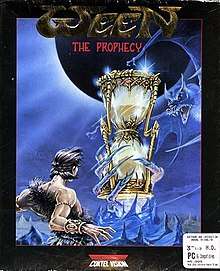The Prophecy (video game)
The Prophecy (known in Europe as Ween: The Prophecy) is a point-and-click adventure game in a fantasy setting, developed by Coktel Vision and MDO, released in Europe in 1992 for MS-DOS, Amiga, and Atari ST. It was published by Sierra On-Line in North America in 1993. A German retail version was released.[1]
| The Prophecy | |
|---|---|
 European cover art | |
| Developer(s) | Coktel Vision |
| Publisher(s) | |
| Designer(s) | Joseph Kluytmans Corinne Perrot |
| Programmer(s) | Eric Audren Eric Thommerot Philippe Lamarque |
| Artist(s) | Joseph Kluytmans Pascal Pautrot Rachid Chebli |
| Composer(s) | Charles Callet |
| Platform(s) | Amiga, Atari ST, MS-DOS |
| Release | |
| Genre(s) | Adventure |
| Mode(s) | Single-player |
Gameplay and plot
The game takes place in the Kingdom of Blue Rocks, in which the player takes the role of a good wizard named Ween, who is tasked to take on the evil wizard Kraal. In three days' time, at the day of the Great Eclipse, Kraal plans to take over the kingdom. However, a prophecy states that, if three grains of sand are placed in the Revuss hourglass at the day of the eclipse by a brave hero, Kraal's doom would be sealed. To fulfill the prophecy in the limited time of three days, the player must go on three quests, solving various puzzles along the way to be rewarded three grains of sand that the player must place in the Revuss hourglass.
Objects around the levels are detected by the cursor. Generally the player have to solve each puzzle in sequence. Like in the company's Gobliiins series, the player character cannot die. The game experiments with the toning of the graphics, using a faux-sepia style outside and some bright colours inside, which changes the atmosphere somewhat.
Critical reception
Quandrey gave it 80%, writing that they game might turn off some players due to its restrictive movement that only frees up once players have completed a particular puzzle.[2] Metzomagic gave it 80%, praising its "complete lack of combat" as one of the appealing aspects of the "absorbing and challenging" adventure game."[3] Ace Magazine felt the game's levels were varied and aesthetically pleasing.[4] CU Amiga Magazine felt the puzzles were completely illogical.[5]
Adventure Gamers gave it 40%, commenting that for players who don't particularly enjoy inventory puzzles, the game easily becomes "obscure, tedious, and, well… plain unenjoyable".[6] Tap-Repeatedly/Four Fat Chicks gave the game 20%, writing that while some good games are forgotten due to circumstances out of their control, this forgettable title was rightly left in the potholes of history.[7]
References
- "Amiga Reviews: Ween". 2008-09-09. Archived from the original on 2008-09-09. Retrieved 2018-04-19.CS1 maint: BOT: original-url status unknown (link)
- "Ween: The Prophecy Review by Quandary". Archived from the original on 2008-01-26. Retrieved 2014-09-29.
- "Ween: The Prophecy Review by metzomagic.com". www.metzomagic.com.
- ACE Magazine Issue 35. August 1990.
- CU Amiga Magazine Issue 035. January 1993.
- http://www.adventuregamers.com/redirect/article/673
- "Four Fat Chicks -- The Prophecy Review". www.tap-repeatedly.com.